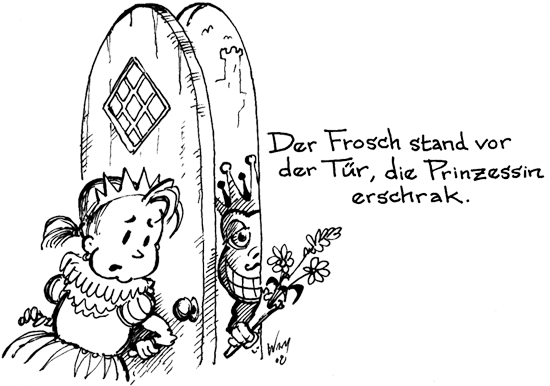![]() Miscellaneous:Die Zeichensetzung
Miscellaneous:Die Zeichensetzung
An essential part of learning to write in German is learning how to properly use German punctuation - a system of marks or signs that are placed in a text to clarify meaning and separate structural units. Luckily, German punctuation is similar to English punctuation in many respects.
![]() Punctuation marks (Satzzeichen)
Punctuation marks (Satzzeichen)
With the exception of quotation marks, the German punctuation marks are the same as the English ones.
| German term | English term | Punctuation mark |
| die Anführungszeichen | quotation marks | " " or « » |
| die Auslassungspunkte | ellipsis dots | ... |
| das Ausrufezeichen | exclamation mark | ! |
| der Apostroph | apostrophe | ' |
| der Bindestrich | hyphen | - |
| der Doppelpunkt/das Kolon | colon | : |
| der Ergänzungsstrich | dash | – |
| das Fragezeichen | question mark | ? |
| der Gedankenstrich | long dash | — |
| runde Klammern | parentheses | ( ) |
| eckige Klammern | brackets | [ ] |
| das Komma | comma | , |
| der Punkt | period | . |
| das Semikolon | semicolon | ; |
However, four of these German punctuation marks - quotation marks, the apostrophe, the comma and the dash - differ from their English counterparts in terms of how they are used.
![]() Die Anführungszeichen
Die Anführungszeichen
| Difference | German usage | English usage |
| Marks |
* Generally, chevron-style marks are used in books
Beispiel: (or) Die Prinzessin sagte: »Du garstiger Frosch!« * In newspapers and other printed material, German quotation marks are used (i.e., the opening quotation mark is below the line rather than above)
Beispiel: |
* International quotation marks are used in all types of texts Example: The princess said, "You nasty frog!" |
| Introducing a quotation |
A colon is used to introduce a direct quote.
Beispiel: |
A comma is used to introduce a direct quote.
Example: |
| Ending a quotation |
At the end of a quotation, the comma is placed outside the quotation mark.
Beispiel: |
At the end of a quotation, the comma is placed inside the quotation mark.
Example: |
| Quotations vs. italics |
* Quotation marks are used for the titles of poems, articles, short stories, songs and TV shows.
Beispiel: * Quotation marks are also used for the titles of books, novels, films, dramatic works and the names of newspapers or magazines.
Beispiel: |
* Single quotation marks are used for the titles of poems, articles, short stories, songs and TV shows.
Example: * The titles of books, novels, films, dramatic works and the names of newspapers or magazines are either italicized or underlined.
Example: |
| Quotations within quotations |
* Single quotation marks (halbe Anführungszeichen) are used for a quotation within a quotation.
Beispiel: |
* Single quotation marks are used for a quotation within a quotation
Example: |
![]() Der Apostroph
Der Apostroph
| Difference | German usage | English usage |
| Genitive possession |
* Generally, genitive possession is indicated with just an -s at the end of a name or noun.
Beispiel: * When a name or noun ends with an s sound (i.e., spelled -s, -ss, -ß, -tz, -z, -x, -ce), genitive possession is indicated with just an apostrophe
Beispiel: |
* Genitive possession is indicated with both an apostrophe and an -s
Example: * Example: The prince's steed |
| Missing letters |
* Missing letters in contractions, slang, dialect, idiomatic expressions or poetic phrases are indicated with an apostrophe
Beispiele: * In some common contractions with definite articles, no apostrophe is used
Beispiele: |
* Missing letters in contractions, slang, dialect, idiomatic expressions or poetic phrases are indicated with an apostrophe
Examples: |
![]() Das Komma
Das Komma
| Difference | German usage | English usage |
| Linking clauses |
* A comma may link two independent clauses without a conjunction; the other options are a semicolon or a period.
Beispiel: |
Generally, a comma is not an option when linking two independent clauses without a conjunction; a semicolon or a period is more appropriate.
Example: |
| Series ending with and/or |
* A comma is never used at the end of a series ending with and/or.
Beispiel: |
* A comma is optional at the end of a series ending with and/or.
Example: |
| Infinitive phrases |
* The reformed spelling rules (Rechtschreibreform) make commas optional in infinitive phrases Beispiel: Die Prinzessin verliess den Brunnen(,) ohne den Frosch mitzunehmen. |
n/a |
| Numerical expressions |
* In prices, a comma separates the tens position from the ones position.
Beispiel: * In large numbers, either a space or a decimal point divides thousands
Beispiel: |
* In prices, a decimal point separates the tens position from the ones position.
Example: * In large numbers, a comma divides thousands
Example: |
![]() Der Ergänzungsstrich/Der Gedankenstrich
Der Ergänzungsstrich/Der Gedankenstrich
| Difference | German usage | English usage |
| Pauses, delayed continuation, contrast |
* A dash or long dash indicates a pause, a delayed continuation or a contrast.
Beispiel: |
* A dash or long dash indicates a pause, a delayed continuation or a contrast.
Example: |
| Change in speaker |
* When there are no quotation marks, a dash or long dash indicates a change in speaker.
Beispiel: |
* Generally, quotation marks indicate a change in speaker.
Example: |
| Prices |
* A dash or long dash indicates an even price.
Beispiel: |
* A double zero or naught indicates an even price.
Example: |


